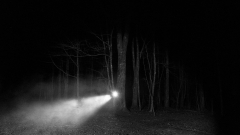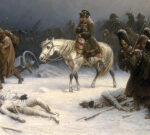In the early winter months of 1897, a woman named Mary J. Heaster found herself in regular prayer. Her daughter, Elva Zona Heaster Shue, had just died that January. Only recently married, Zona (as she was known) was a young woman, and her “death by heart disease”—as the county coroner had determined—weighed heavily on Mary. Had the coroner gotten the cause of death wrong? Mary prayed that her daughter would return to guide her toward an answer.
And according to recorded court testimony from July 1897, Zona did return to speak to her mother over the course of four nights that winter. She told her mother where to find her blood. She told her where on the spine her neck had been broken. She told her who did it.
With her daughter’s ghostly testimony in hand, Mary proceeded to have her daughter’s body exhumed. This new evidence resulted in a murder conviction for Zona’s former husband, the blacksmith E. S. Shue, who was sent to prison in Moundsville, West Virginia, where he later died.
The tale of the “Greenbrier Ghost,” as Zona has come to be known, is a quintessential Appalachian ghost story. It’s got a spectral return for the purposes of justice. It has a traumatic event that is experienced at the communal level. And, perhaps most significantly, the story relies on strong matrilineal ties to realize its resolution; after all, an unwavering mother must raise her voice to reopen her beloved child’s case.
(Haunted Appalachia? These ancient mountains witnessed the birth of man and monster.)
With trending social media hashtags like #hauntedappalachia driving millions of video views, broad interest in the region’s lore is at an all-time high.The #hauntedappalachia videos range from sincere to playful to mercenary, allegedly offering a window into the daily spectral realities of people in Appalachian states. Some co-opt Indigenous traditions from the region—and around the country—and place them in Appalachia. Others clearly mock the trend, aiming to poke fun at the idea that an entire region is populated by a seemingly inexhaustible supply of boogers, haints, witches, cryptids, and—of course—babies crying in the woods at night. Some, like many trends on social media, seem mostly intended to just get as many views as possible.

In reality, very little of the #hauntedappalachia chatter takes up the real lore that makes the region so rich in spooky storytelling. Instead, it, perhaps unwittingly, participates in a longstanding fascination—and even revulsion—outsiders have with Appalachia. Many of the videos suggest a fundamental malevolence lurking in the hills and hollers.
For the late folklorist Ruth Anne Musick, this would have been a fundamental misreading of so many Appalachian specters. As perhaps the region’s most prominent collector of ghost tales, Musick believed the ghosts of West Virginia were more like “angels of the underdog” than fearsome ghouls bent on keeping Appalachians indoors.
Angels of the underdog
West Virginia, where Zona’s story unfolds, is located in the heart of the Appalachian region. It’s a place rich in oral tradition and populated by ghosts seeking justice, ghosts offering protection, and ghosts whose stories provide a window into the inner lives of the people who live there, their “beliefs, fears, and hopes,” as the West Virginia folklorist Judy Prozzillo Byers describes it.
All of these qualities of the story are what scholars call “motifs,” and these specific motifs can be found across Appalachian ghost tales. The Telltale Lilac Bush, a landmark work collected by Musick and stewarded by Byers, of these spectral stories, is rife with them.
(The tragic backstory of one of the most haunted roads in America.)
There’s the tale of the coal miner whose reason for return is to save a fellow miner called “Big John’s Ghost.” There’s a story about a deceased little ghost girl who returns to aid her sick mother. And there are countless other examples of spe





